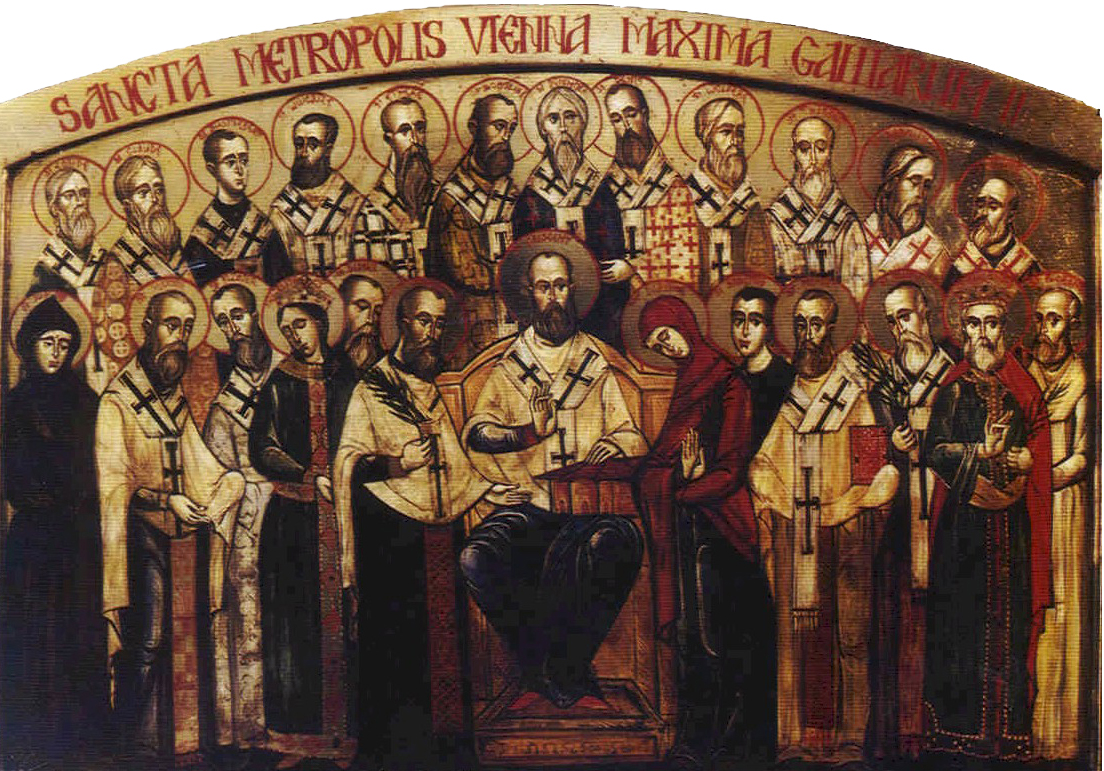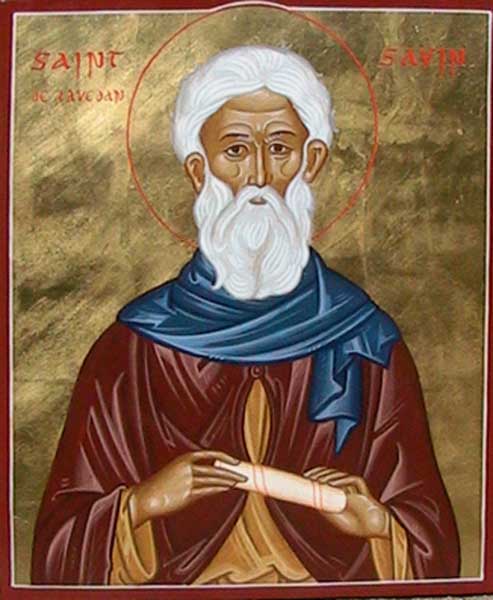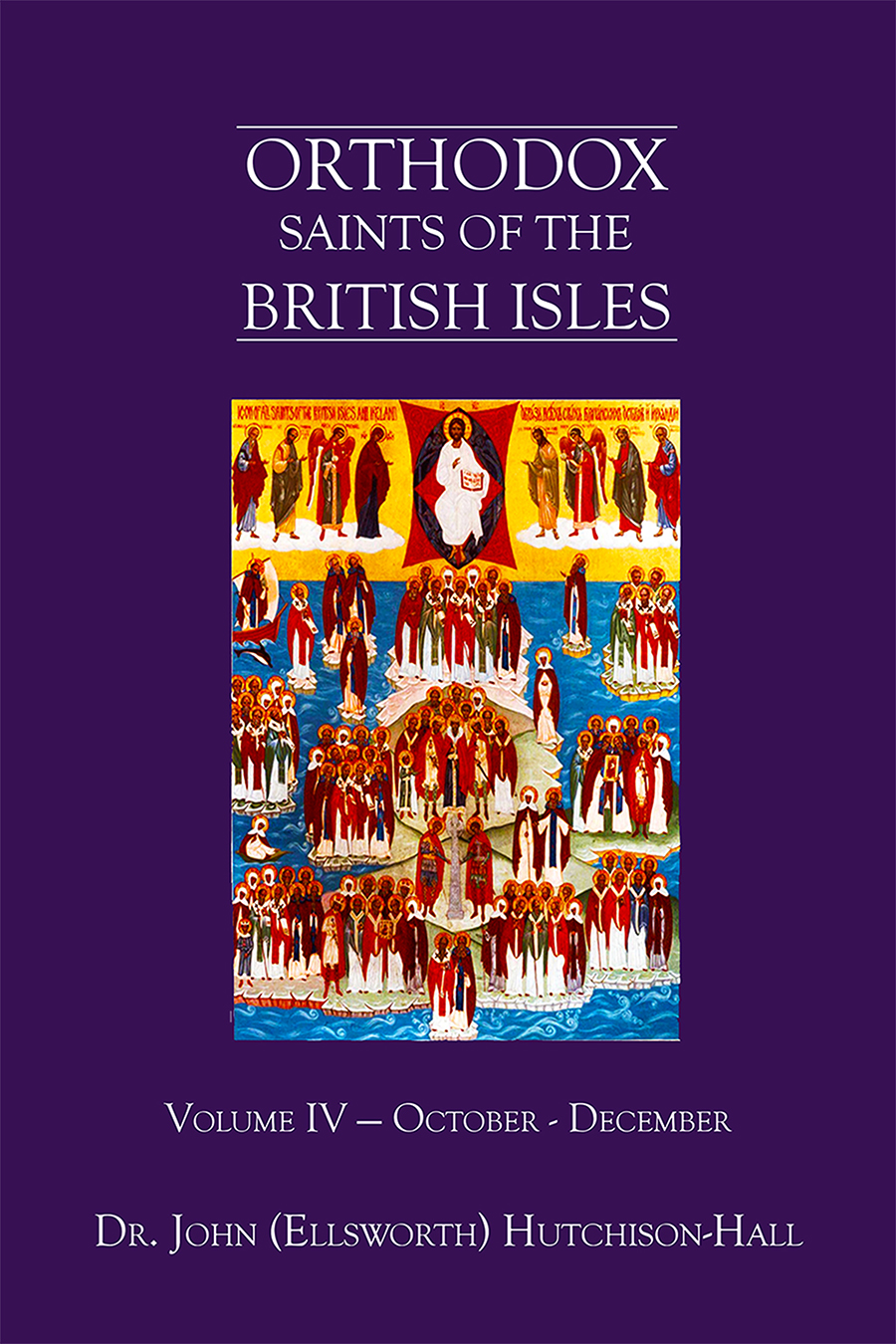
Orthodox Saints of the Pre-Schism
See of Rome
22nd October (NS) — 9th October (OS) 2024
DENIS (DIONYSIUS) of PARIS, RUSTICUS, and ELEUTHERIUS, St. Denis has for many years been regarded as the patron saint of France. According to St. Gregory of Tours (17th November), St. Denis was sent circa 250 to preach the Gospel at Lutetia Parisiorum (present-day Paris), and served as the first Bishop of Paris. He was beheaded with the priest Rusticus and the deacon Eleutherius at Montmartre (Hill of the Martyrs) circa 258. The Abbey of Saint-Denis, where French kings were interred, was built on the site of their martyrdom. According to a later legend, St. Denis carried his severed head from Montmartre to his burial place at Vicus Catulliacus, the present-day Parisian suburb of St. Denis.
DEUSDEDIT of MONTE CASSINO, the fifteenth Abbot of Monte Cassino, a man of great learning and holiness of life, who was especially renowned for his almsgiving. St. Deusdedit was kidnapped in 836, and attempts were made to extort money in exchange for his release, however, he was subject to torture during his captivity resulting in his repose before any money was paid. St. Deusdedit was subsequently venerated as a martyr.
DOMNINUS (DONNINO), a native of Parma (northern Italy) who, according to tradition, was a chamberlain in the Milanese court of Emperor Maximian Herculeus (r. 286–305), and a secret convert to Christianity. When Maximian learnt of the conversion in 304, he ordered St. Domninus’ arrest. St. Domninus fled in the hopes of avoiding capture, heading towards Rome on the Via Claudia Augusta, but was captured and beheaded not far from Parma.
GEMINUS, patron saint of the village of San Gemini in Umbria (central Italy). St. Geminus reposed circa 815.
GHISLAIN (GISLENUS, GUISLAIN) of MONS, an anchorite who lived in the forest in Hainault, near present-day Mons in Belgium. As disciples gathered around him, St. Ghislain built the Abbey of SS. Peter and Paul (abbaye Saint-Pierre et Saint-Paul), now the Abbey of St. Ghislain (abbaye Saint-Ghislain). He served as abbot for about thirty-five years before reposing circa 680.
GUNTHER of NIEDERALTEICH, Duke of Thuringia, and related to several central European royal families, St. Gunther enjoyed a worldly life as a member of Court. Then in 1005, at the age of fifty, he was brought to repentance by St. Godehard of Hildesheim (4th May) and in penance for his heretofore misspent life, resolved to enter monastic life. For this reason, the following year, St. Gunther, following a pilgrimage to Rome, received monastic tonsure at the Abbey of St. Maurice Niederaltaich (Abtei Heilige Moritz Niederaltaich) in Bavaria (southern Germany). However, his pride and worldly ambition soon reared its head and St. Gunther, against the counsel of St. Godehard, insisted on becoming Abbot of Göllingen Abbey in North Thüringen (east-central Germany), which St. Gunther had endowed and retained ownership of. Needless to say, as a novice in the monastic life, he was not successful in this role, and in humility went to live as a hermit in the Bavarian Forest near the Czech border about 100 km (60 miles) east of Regensburg. In time, a community grew around him which became the Rinchnach Priory, a dependency of Niederaltaich. St. Gunther reposed at Hartmanitz (present-day Hartmanice in the Czech Republic) in 1045.
LAMBERT and VALERIUS (BELLÈRE, BERIHER), disciples of St. Ghislain (vide supra) in Hainault near Mons in present-day Belgium. They reposed circa 680.
SABINUS (SAVIN) of the LAVEDAN, Apostle of the Lavedan, according to tradition, St. Sabinus was a native of Barcelona (north-eastern Spain), educated at Poitiers (west-central France) and received monastic tonsure at the Abbey of St. Martin of Ligugé (abbaye Saint-Martin de Ligugé) in Vienne (south-eastern France), later living as a hermit. He is believed to have reposed circa 820.
Get your copy of Orthodox Saints of the British Isles today.
Available at Amazon or your favourite e-bookstore.
BENEDICT (BENOÎT) of MASSERAC, originally an abbot at the monastery in Petras (south-western Jordan), St. Benedict travelled west settling in Masserac near Nantes (Upper Brittany, western France). There he lived as a hermit. In time, the number of disciples who gathered round him were such to necessitate a monastery, which he built and served as abbot. St. Benedict reposed in 845.
BERTHARIUS of MONTE CASSINO, a scion of the Capetian dynasty, St. Bertharius left the world and entered St. Benedict of Nursia's (21st March) monastery at Monte Cassino. In 856 he was selected to serve as Abbot of Monte Cassino, and in 844, along with several of his monks, was martyred by Saracens, whilst at prayer.
DONATUS of FIESOLE, an Irishman well known for his piety and erudition. Whilst returning from a pilgrimage to Rome circa 824, St. Donatus and his disciple St. Andrew of Fiesole (22nd August) passed though Tuscany (central Italy), where, due to his renown, he was selected, by popular acclaim, to be Bishop of Fiesole near Florence. St. Donatus served the See of Fiesole for some fifty years, reposing circa 874.
LEOTHADIUS (LÉOTHADE) of AUCH, a Frankish noble who received monastic tonsure at the Abbey of St. Peter (abbaye Saint-Pierre de Moissac) in the Duchy of Aquitaine (south-western France), later serving as its Abbot. In 691, St. Leothadius was consecrated Bishop of southwestern France, serving until his repose in 718. St. Leothadius's relics are enshrined in the crypt of the Cathedral Basilica of Saint Mary of Auch (Basilique Cathédrale Sainte-Marie d'Auch).
MAROVEUS of PRECIPIANO, a monk at the Abbey of St. Columbanus at Bobbio, in present-day Emilia-Romagna, Italy. St. Maroveus went on to found an abbey at Precipiano near Tortona in Piedmont (north-western Italy). He reposed circa 650.
MELLON, St. Mellon, or Milanius as he is styled in the Roman Martyrology, is the subject of many traditions with little factual basis. It is commonly believed he was a native of Wales or Cornwall, and whilst in Rome, was sent to evangelise northern Gaul. There he founded and served as the first Bishop of the See of Rouen (Normandy north-western France). St. Mellon is said to have been a wonderworker, and following a long and fruitful episcopacy, retired to live as a hermit until his repose on 11th November, 314.
MODERAN (MODERAMNUS, MORAN) of RENNES, Consecrated seventh Bishop of Rennes in Brittany (north-western France), in 703, St. Modern ruled that See until circa 720. In that year, he resigned his See, made a pilgrimage to Rome, and spent the rest of his years as a hermit at Berceto in present-day Emilia-Romagna, Italy, reposing circa 730.
NEPOTIAN (NEPOTIANUS) of CLERMONT, the fifth Bishop of Clermont, in the Auvergne region of present-day France, from circa 386 until circa 388.
NUNCTUS (NOINT) of MÉRIDA, a seventh century abbot of a monastery near Mérida (western central Spain). Bandits murdered St. Nunctus in 668, and he has been venerated as a martyr ever since.
NUNILO of HUESCA and ALODIA of HUESCA, daughters of a Muslim father and Christian mother, who were raised as Christians in Huesca, Emirate of Córdoba (southern Spain). After being widowed, their mother married again, also to a Muslim. Their stepfather treated them with great brutality, and ultimately turned them over to the authorities, who imprisoned them. SS. Nunilo and Aldodia were beheaded in 851 in the persecution of Christians during the reign of Emir Abd ar-Rahman II (r. 822–852).
PHILIP of FERMO, little is known about St. Philip, aside from serving as Bishop of Fermo (central Italy). It is commonly accepted that St. Philip was martyred, circa 270, in the persecution of Christians during the reign of the Emperor Aurelian (r. 270–275). His relics are enshrined in the Cathedral of the Assumption of the Virgin Mary (Cattedrale metropolitana di Santa Maria Assunta in Cielo) in Fermo, Italy.
SIMPLICIUS of MONTE CASSINO, a disciple of St. Benedict of Nursia (21st March) who later served as the third Abbot of Monte Cassino. St. Simplicius reposed circa 570.
VALERIUS (VALIER) of LANGRES, an early fifth century deacon and disciple of Desiderius of Langres (23rd May). St. Valerius worked to spread the Gospel amongst the pagans in Langres (north-eastern France) and its environs. St. Valerius was martyred on 22nd October, 411 by Vandals who beheaded him near Besançon, (eastern France).
VERECUNDUS, a Bishop of Verona (northern Italy) who reposed in 522. No further details of his life are extant.
Prior to the Schism the Patriarchate of Rome was Orthodox, and fully in communion with the Orthodox Church. As Saint John of Shanghai and San Francisco +1966 said “The West was Orthodox for a thousand years, and her venerable Liturgy is far older than any of her heresies”.
Details of British Saints excerpted from Orthodox Saints of the British Isles.
Details of continental saints from these sources.
In many cases there are several spelling versions of the names of saints from the British Isles. I use the Oxford Dictionary of National Biography version as the primary version with the more prevalent version in parenthesis e.g. Ceadda (Chad) of Lichfield.



